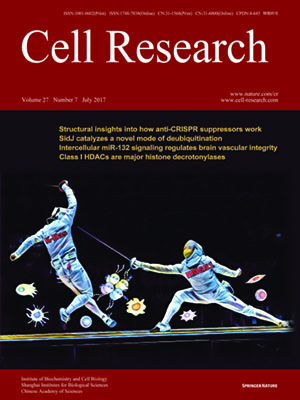
Volume 27, No 7, Jul 2017
ISSN: 1001-0602
EISSN: 1748-7838 2018
impact factor 17.848*
(Clarivate Analytics, 2019)
Volume 27 Issue 7, July 2017: 946-949
LETTERS TO THE EDITOR
Global profiling of crotonylation on non-histone proteins
Weizhi Xu1,*, Junhu Wan1,*, Jun Zhan1, Xueying Li1, Huiying He1,2, Zhaomei Shi3 and Hongquan Zhang1
1Department of Human Anatomy, Histology and Embryology, Key Laboratory of Carcinogenesis and Translational Research (Ministry of Education), State Key Laboratory of Natural and Biomimetic Drugs, Peking University Health Science Center, Beijing 100191, China
2Department of Pathology, Peking University Health Science Center, Beijing 100191, China
3Jingjie PTM BioLab Co.Ltd., Hangzhou Economic and Technological Development Area, Zhejiang 310018, China
Correspondence: Hongquan Zhang, Tel: +86 10 82802424(Hongquan.Zhang@bjmu.edu.cn)
Lysine crotonylation is a posttranslational modification (PTM) of histone proteins originally identified by Tan et al.1. This novel evolutionarily conserved histone modification was identified on 28 lysine sites on various histones1. Lysine crotonylation occurs primarily on the ε-amino group of lysine, but its planar orientation and four-carbon length distinguish it from lysine acetylation. Histone crotonylation specifically labels the enhancers and transcription starting sites of active genes in both the human somatic cell genome and the murine male germ cell genome. Histone crotonylation, like acetylation, affects chromatin structure and facilitates histone replacement in elongating spermatids1. Recently YEATS domain-containing protein YEATS2 was found to be a selective histone crotonylation reader2.
10.1038/cr.2017.60
FULL TEXT | PDF
Browse 2749


